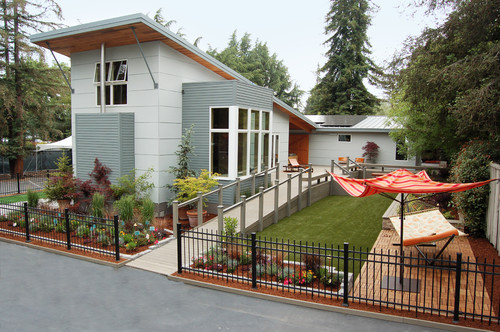Wendy Koch, USA TODAY
USA TODAY
Just how tough is the passive house standard that’s starting to catch on in the United States? I put my own new green house to the test.
My house, nearing completion in Falls Church, Va., wasn’t designed to meet the rigorous passive standard, which focuses solely on energy efficiency, but rather the top rating of a more general program by the U.S. Green Building Council. Yet it has many of the same features of certified passive homes, so I figured: why not try?
After all, my project has high-performance windows by Serious Mate rials, a well-insulated and sealed exterior (we used structural in sulated panels or SIPS) and ultra-efficient appliances and lighting (only LEDs and compact fluorescent lamps.) Really, how hard could it be?
John Semmelhack, a passive house expert in Charlottesville, Va., who runs the Think Little consul ting firm and advised on how to make a Waldorf school meet the passive standard, agreed to do a preliminary analysis of my project for this story. I anxiously awaited his results.
He let me down gently. “While the house is going to be a very energy efficient house, it’s not going to meet the Passive House standard,” he wrote in an e-mail that reported his findings. He explained them in a phone interview.
“The biggest problem by far is your windows,” he said. My house simply has too many of them, and the large south-facing windows don’t capture enough solar energy because of their glazing and less-than-optimal siting. (To get the perfect southern angle, the house would have needed to sit diagnally on the lot, which would look odd.)
Windows absorb more solar power if the glass has a high “solar heat gain coefficient” or SHGC. But since we have a shady lot and the U.S. government’s Energy Star program doesn’t recommend high SHGC windows for the Mid-Atlantic region, we didn’t request such glazing.
The second biggest issue, Semmelhack said, is the home’s geometry. It’s not a simple cube. My L-shaped home opens to a south-facing courtyard, so it’s more spread out than a colonial or a foursquare, which is an easier shape to make energy efficient. Its top floor also overhangs the main level in both the front and back, which looks cool but creates potential thermal breaks.
Semmelhack said the home’s foundation, walls and windows could also have benefited from a bit more insulation, but he said we didn’t miss the mark by much.
He said the Mid-Atlantic is a tricky place to do a passive home, because “we get a little bit of Maine and a little bit of Florida.” Homes certified by the Passive House Institute US, a private Illinois-based group, need to have annual heating or cooling loads be low 4,750 British thermal units per square foot of interior finished space, which is about 10 times less than many regular new homes.
Semmelhack figured my heating load was about twice the passive standard while my cooling load was about 30% higher. My home’s overall energy use was about 20% higher than the standard’s maximum of 38,000 Btu per square foot of interior finished space per year. He said we could opt for a slightly more efficient Rinnai tank less water heater, but the conventional Carrier Infinity heating and cooling system we selected is just fine. “It’s about as good as you can get,” he said, noting its 95% efficiency rating.
The passive standard also requires homes be virtually air tight, limiting the air changes per hour (at 50 pascals) to 0.60, which is a fraction of what the Energy Star program al lows.
I don’t know yet how well my house will fare on this measure, because we haven’t done our final blower door test. But my builder, Arjay West of West Properties, did preliminary checks before enclosing the walls in drywall and tried to address any thermal breaks. Since my house isn’t a simple cube, though, sealing it is more of a challenge. We’ll keep you posted on our progress.
Source: USA Today









